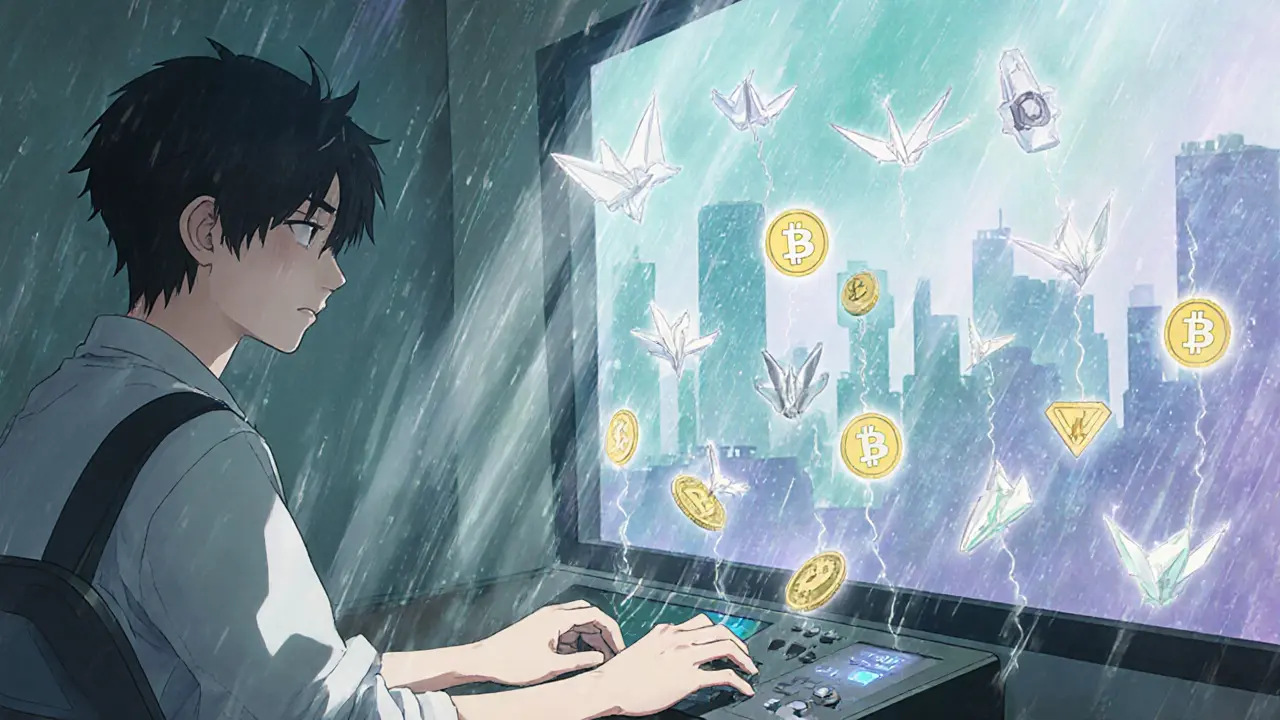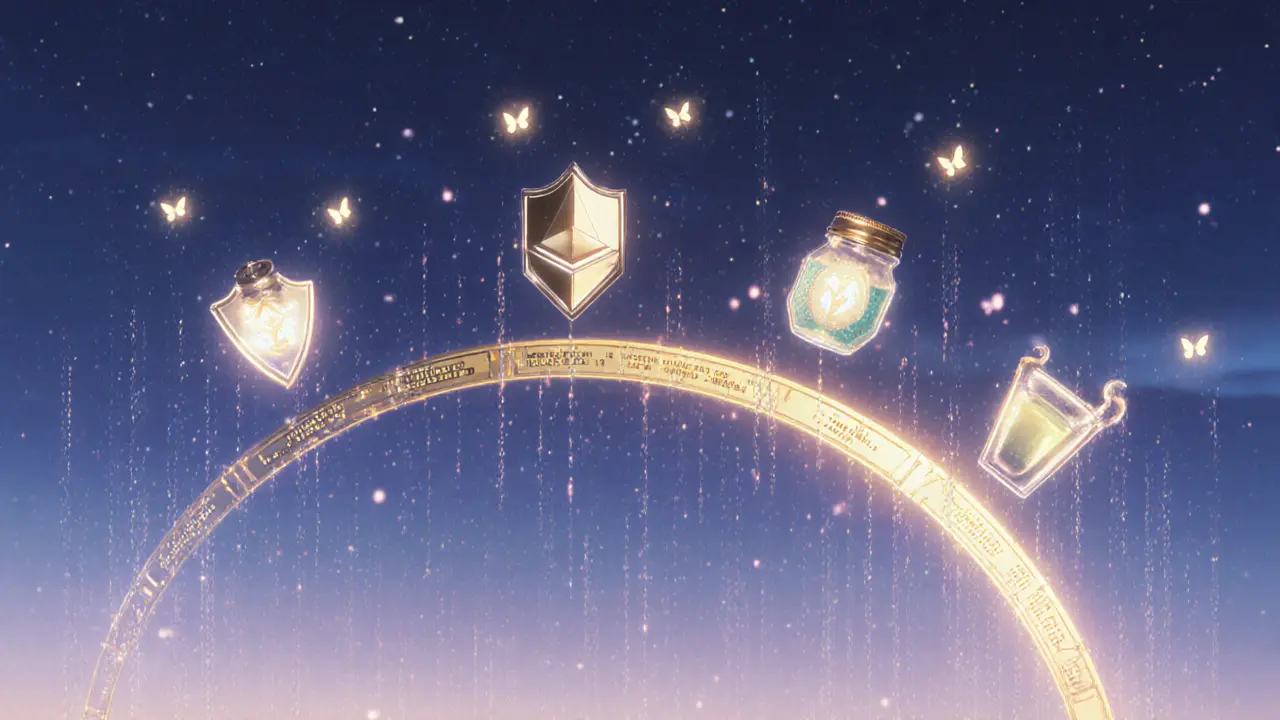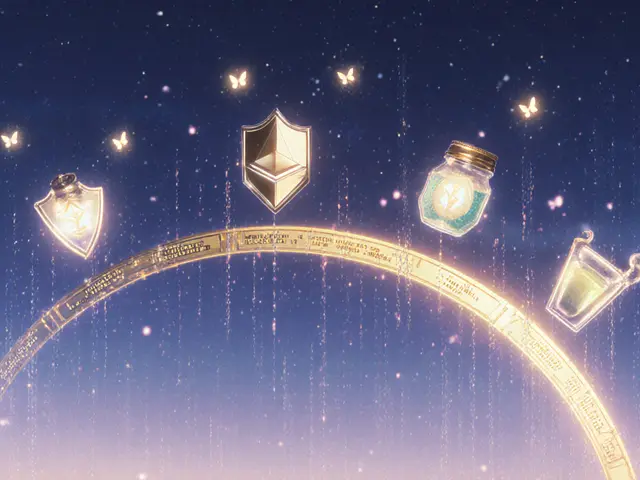Imagine buying five different items in a game - a sword, a shield, three potions - and doing it all in one click, with one transaction, and paying less than half the gas fee you’d normally pay. That’s not science fiction. That’s what ERC-1155 makes possible on Ethereum.
Before ERC-1155, if you wanted to handle both regular tokens (like coins) and unique items (like rare skins or weapons), you had to use two separate systems: ERC-20 for fungible tokens and ERC-721 for NFTs. Each one needed its own smart contract. That meant more code, more bugs, more gas, and more headaches. ERC-1155 changed all that. It’s a single standard that lets you create, send, and manage both fungible and non-fungible tokens in one contract. No more juggling multiple systems. No more paying for five separate transactions when you could’ve done it in one.
How ERC-1155 Works: One Contract, Many Tokens
At its core, ERC-1155 uses a simple but powerful idea: every token type gets a unique ID. Think of it like a product code in a warehouse. ID #1 might be a common health potion (1,000 copies exist). ID #2 might be a legendary dragon sword (only one exists). The same contract handles both. You don’t need to deploy a new contract for each item. That’s a game-changer for games, apps, and platforms that manage hundreds or thousands of digital items.
The magic happens in the functions. balanceOf tells you how many of a token you own. safeTransferFrom moves tokens securely. And setApprovalForAll lets you approve one address to move any of your tokens - all at once. No more approving each NFT individually. You can even batch transfers: send 10 different items to 5 different people in a single transaction. Enjin’s documentation shows this can handle up to 10,000 token transfers in one go. That’s not just convenient - it’s revolutionary for digital economies.
Security is built in too. The onERC1155Received hook checks if the receiving address can handle ERC-1155 tokens. If it can’t - say you accidentally send tokens to a wallet that doesn’t support them - the transaction reverts. Your tokens go back to you. No more lost assets because you sent an NFT to the wrong place. ChainSafe’s analysis confirms this feature has cut accidental losses by over 80% compared to older standards.
Why Gas Fees Drop by 40-60%
Gas fees are the biggest pain point on Ethereum. ERC-1155 slashes them by combining operations. Let’s say you want to send 10 NFTs using ERC-721. Each one needs its own transaction. That’s 10 separate calls to the blockchain. Each costs around 22,000 gas. Total? Around 220,000 gas.
With ERC-1155? One transaction. One call. One batch. The gas cost? About 125,000 gas. That’s a 43% reduction - and it gets even better as you add more items. Merkle Science’s March 2024 data shows that sending 50 unique items via ERC-721 would cost over 1 million gas. With ERC-1155? Still under 150,000 gas.
It’s not just about NFTs. If you’re sending 100 fungible tokens (like in-game currency), ERC-20 would need 100 transfers. ERC-1155 does it in one. That’s why blockchain games like The Sandbox use it so heavily. They manage over 1.2 million in-game items - weapons, armor, tools - all in one contract. An ERC-721 version would need 1.2 million contracts. That’s not scalable. It’s impossible.

Where ERC-1155 Shines (and Where It Doesn’t)
ERC-1155 isn’t perfect for everything. It’s built for efficiency, not exclusivity. That’s why it dominates in gaming and virtual worlds. The Sandbox, Decentraland, and hundreds of other play-to-earn games rely on it. DappRadar’s Q2 2024 report shows 68.3% of blockchain games use ERC-1155. That’s not a coincidence. It’s the right tool for the job.
But if you’re selling a one-of-a-kind digital artwork - say, a rare CryptoPunk or a generative art piece - ERC-721 still wins. Why? Because the market expects uniqueness to be explicit. ERC-721 says, “This is one of a kind.” ERC-1155 says, “This is one of 100.” Even if you set the supply to one, some buyers still trust ERC-721 more for high-value art. CoinDesk’s March 2024 analysis points out that collectors often avoid semi-fungible tokens for fine art because the concept feels too technical.
Another issue? Marketplaces get confused. DappRadar found that 12.3% of ERC-1155 listings are mispriced because users don’t realize a token can be both fungible and non-fungible. You might list a common armor as 1 ETH, but someone else lists the exact same item (same ID) as 0.01 ETH because they have 500 of them. Buyers get mixed up. Sellers lose money. It’s a UX problem, not a tech problem - but it’s real.
Developer Experience: Powerful, But Not Easy
For developers, ERC-1155 is a double-edged sword. It’s powerful. It’s efficient. But it’s complex. Reddit user u/GameDevAlex spent weeks debugging their game’s token system. “Cut our gas costs by 57%,” they said, “but the tooling was a nightmare.” OpenZeppelin offers audited code templates, and ThirdWeb gives you pre-built deployers. But if you’re new to Solidity, the learning curve is steep. ThirdWeb estimates it takes 2-3 weeks to get comfortable with ERC-1155 - compared to 1-2 weeks for ERC-721.
One big pain point? Debugging. GitHub issue #1143 on OpenZeppelin’s repo has 87 upvotes because developers are frustrated by the lack of good debugging tools. Unlike ERC-721, where you can trace each token individually, ERC-1155 bundles everything. When something goes wrong, you’re digging through logs for a specific token ID. It’s harder.
Also, wallet support isn’t universal. Some wallets still don’t display ERC-1155 tokens properly. DappRadar’s Q1 2024 survey found 37.8% of users reported inconsistent display or transfer issues. WalletConnect added native support in May 2024, and now 87 wallets handle it - but that’s still not all of them.

Real-World Use Cases Beyond Gaming
Gaming is the big winner, but ERC-1155 is spreading. Gartner’s May 2024 survey found 42 Fortune 500 companies are testing it for loyalty programs. Imagine a coffee chain giving you 10 free drinks (fungible) and one exclusive mug (non-fungible) - all in one token. Or a supply chain where each product has a unique ID (NFT) but also comes with 3 reusable packaging tokens (fungible). That’s the power of semi-fungibility.
Even the SEC is paying attention. Their March 2024 guidance flagged semi-fungible tokens as creating “novel classification challenges.” Are the fungible parts securities? Are the NFT parts collectibles? The answer depends on context. That uncertainty slows down enterprise adoption - but it also means regulators are finally catching up to the tech.
What’s Next for ERC-1155?
The future looks bright. Ethereum’s Cancun upgrade (coming Q3 2024) will reduce gas costs even further for batch transactions. Polygon, Avalanche, and BNB Chain all added native ERC-1155 support in early 2024. That means you can now use it across multiple chains without rewriting code.
EIP-6059, a proposed upgrade to improve metadata handling, is under review. If approved, it’ll make token descriptions clearer and more reliable. That’s huge for marketplaces and user trust.
Deloitte forecasts 23.7% annual growth in ERC-1155 adoption through 2027. Gartner predicts it’ll become the dominant standard for multi-asset applications by 2026. But MIT’s Digital Currency Initiative warns that the concept of semi-fungibility might be too confusing for average users. If people don’t understand whether their item is unique or mass-produced, adoption beyond gaming could stall.
For now, if you’re building something with lots of digital items - games, virtual worlds, digital collectibles, loyalty programs - ERC-1155 is the smartest choice. It’s faster, cheaper, and more scalable. Just be ready for the learning curve. And if you’re just selling one rare piece of art? Stick with ERC-721. The market still prefers it.
What’s the difference between ERC-1155 and ERC-721?
ERC-721 is for unique, one-of-a-kind tokens - like a single digital artwork. Each token needs its own contract. ERC-1155 lets you create both unique items and bulk tokens (like coins or potions) in one contract. It’s more efficient, cheaper, and supports batch transfers.
Can ERC-1155 tokens be traded on NFT marketplaces?
Yes, but only if the marketplace supports ERC-1155. Platforms like OpenSea and LooksRare now support it, but not all do. When listing, you must specify whether the token is fungible (multiple copies) or non-fungible (one copy). Mislabeling can lead to pricing errors.
Is ERC-1155 better than ERC-20 for in-game currency?
It depends. If you only need simple currency, ERC-20 is fine. But if your game also has NFT items (weapons, skins), ERC-1155 lets you manage both in one contract. That reduces complexity and gas costs. Most modern games use ERC-1155 for everything - currency and items alike.
Why do gas fees drop so much with ERC-1155?
Because you can send multiple tokens in one transaction. Instead of 10 separate transfers (each costing 20,000-25,000 gas), you do one batch transfer for around 125,000 gas total. The blockchain doesn’t have to process each item individually. That’s the efficiency gain.
Are ERC-1155 tokens secure?
Yes, if implemented correctly. The built-in onERC1155Received hook prevents tokens from being sent to incompatible wallets. But the complexity of managing multiple token types in one contract introduces new risks - like metadata manipulation or incorrect supply settings. Always audit your contract before launch.
Can I convert ERC-721 tokens to ERC-1155?
No, not directly. They’re different standards with different contract structures. You’d need to create a new ERC-1155 contract, mint new tokens, and transfer ownership manually. Some platforms offer bridging services, but it’s not automatic.
What tools should I use to build with ERC-1155?
Start with OpenZeppelin Contracts v4.9.0 - they offer audited, ready-to-use ERC-1155 templates. Use ThirdWeb’s SDK for easy deployment. Store metadata on IPFS using ENS or Pinata. Test on Sepolia or Goerli before going live. Join the Enjin Discord server - it’s the most active community for support.


Edward Phuakwatana
November 11, 2025 AT 09:45ERC-1155 is the real MVP of Ethereum 🚀 I mean, imagine managing 10k items in one tx? That’s not efficiency-that’s magic. Game devs, stop using 721 like it’s 2021. You’re bleeding gas like it’s free. Enjin’s been screaming this from the rooftops since 2019. Time to wake up and smell the blockchain coffee ☕️
Suhail Kashmiri
November 12, 2025 AT 14:48Ugh, another crypto bro pretending tech solves everything. You think people care about gas fees when they can’t even pay their rent? This is just rich people playing with digital Legos while the world burns. Stop glorifying waste disguised as innovation.
Kristin LeGard
November 14, 2025 AT 12:11Oh please. ERC-1155? More like ‘Ethereum’s 1155 excuses for overcomplicating simple things.’ If you need a PhD to understand your token standard, you’re doing it wrong. We don’t need ‘semi-fungible’-we need functional. And no, ‘batch transfers’ don’t make up for a UX nightmare. USA still leads in tech, but this? This is cringe.
Arthur Coddington
November 15, 2025 AT 13:38Let me just say… this whole thing feels like a metaphor for modern life. We’re told to optimize, to bundle, to compress everything into one click… but at what cost? The soul of digital ownership? The poetry of the unique? ERC-721 was art. ERC-1155 is a spreadsheet. And I’m not okay with it.
Phil Bradley
November 16, 2025 AT 22:49Y’all are overthinking this. I built a game with ERC-1155 last month. Gas dropped 60%, my dev team stopped screaming, and players actually bought stuff because it didn’t cost $20 to buy a sword. Yeah, the tooling’s messy. Yeah, wallets glitch. But guess what? It works. And that’s more than I can say for half the ‘decentralized’ apps out there. Just ship it.
Stephanie Platis
November 18, 2025 AT 09:08Let me be clear: ERC-1155 is not a ‘revolution.’ It is a pragmatic, albeit complex, evolution of token standards. The gas savings are quantifiable, the security features are non-negotiable, and the metadata structure-while imperfect-is infinitely more scalable than the fragmented chaos of ERC-20 and ERC-721. If you’re still using separate contracts in 2024, you’re not a pioneer-you’re a liability.
Michelle Elizabeth
November 20, 2025 AT 01:49It’s funny how ‘efficiency’ becomes the new god. We used to celebrate uniqueness. Now? We’re just batching souls into QR codes. I don’t need 10,000 copies of a dragon sword. I need one that feels like it was forged in a dragon’s heart. ERC-721 had soul. This? This feels like a Walmart aisle.
Joy Whitenburg
November 20, 2025 AT 10:23okay so i tried using erc-1155 last week and my wallet just… didn’t show my stuff? like, i bought a rare hat and it vanished? but then it showed up 3 days later? idk man. i just want to play my game and not be a blockchain engineer. still… the gas thing is kinda wild? like, i bought 5 items for less than $0.50? that’s wild. 🤯
Kylie Stavinoha
November 20, 2025 AT 16:35As someone who has studied digital property rights across cultures, ERC-1155 represents a fascinating shift in how value is conceptualized. In Japan, the notion of ‘mono no aware’-the impermanence of things-finds an unexpected parallel in semi-fungible tokens. A common potion may be mass-produced, yet its context within a player’s journey imbues it with meaning. This standard doesn’t erase uniqueness; it recontextualizes it. A profound evolution, indeed.
Diana Dodu
November 22, 2025 AT 15:35Let me tell you something-this isn’t innovation, it’s corporate control dressed up in blockchain glitter. Why should one company own the contract for 1.2 million items? That’s not decentralization-that’s a monopoly with a fancy API. And don’t even get me started on how this enables microtransactions to become even more predatory. We’re not building a better web-we’re building a better casino.
Raymond Day
November 22, 2025 AT 18:03Okay, but have you seen the bugs? 😭 I spent 3 weeks debugging a token ID conflict where my legendary axe became a health potion because someone mislabeled the metadata. OpenZeppelin’s template? More like ‘OpenZeppelin’s nightmare.’ And don’t get me started on wallets-my grandma can’t even find her sword. We’re making tech that only devs love. And honestly? That’s not progress. That’s a failure.
Noriko Yashiro
November 23, 2025 AT 00:29Actually, this is brilliant. I run a loyalty program for a UK coffee chain, and we just launched a token that gives 10 free coffees + one exclusive ceramic mug. One contract. One UX. One happy customer. No more paper punch cards. No more lost rewards. This isn’t just for gamers-it’s for everyday people who just want to feel rewarded without the headache. Kudos to the devs who made this work.